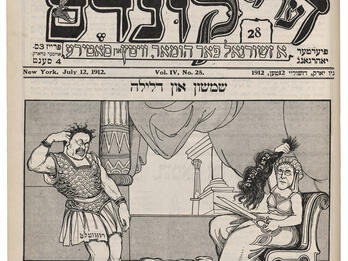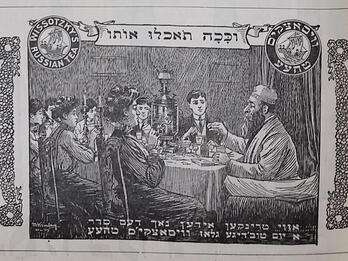Etiquette: Clothing, Manners, and Sexual Behavior
Women’s Clothing
Clothing is an art, and it requires talent from women and men alike. This talent, however, is innate to people. It is a talent that every woman and every man can develop by observing and studying other people’s clothing, having a critical eye, and reflecting on what is appropriate for one person and what suits another.
Everyone is obligated to dress neatly and tastefully. However, very few people have good taste. They follow the fashion—the tyrannical rule of old and new times that prescribes one single style for everyone indiscriminately—and therein lies the tragicomedy.
In this regard men are better off than women. Men’s fashion doesn’t change so often, and the changes affecting men’s clothing are so insignificant that men can definitely wear a full dress suit for twenty years and no one will perceive it as old-fashioned. But the situation is different with regard to women’s clothing. Women’s fashion changes very quickly; a woman who wants to dress according to the latest fashion has to spend half of her time at the dressmaker’s, and she can barely put on one dress a few times before the style changes. [ . . . ]
It is noteworthy that women from poorer social classes are actually more oppressed by fashion than women from wealthier classes. It is a well-known fact that wealthier American women prefer to wear very simple clothes; true, their clothes are made of good-quality material, but they are never the first to catch on to the latest fashion. American women are known throughout the world for their good taste in dressing, and that is why they don’t jump at every new style right away. They have a saying: Don’t be the first to adopt the new or the last to throw away the old. This is the middle road. When the new “spring styles,” the spring fashion, appears, where do you see them first? On Fifth Avenue? On Broadway? On Riverside Drive? No, not on these aristocratic streets, but in the crowded neighborhoods of the East Side. The cold March winds are still blowing and there is still snow on the roofs when young Jewish working girls have already put on their new light-color spring dresses and hats, according to the latest fashion. They don’t take into consideration whether the colors or the style of the dresses and hats go with their faces, the build and form of their bodies; they don’t ask themselves whether the clothes make them look better or worse. As soon as something becomes fashionable, or, rather, as soon as something is about to become fashionable, they think they have to be the first to put it on. They don’t eat, they survive on a banana and a roll, and they literally starve themselves in order to save up for a spring hat and a spring dress. Or, in the words of an American writer: they tear it out of their stomach and put it on their body.
It is awful to consider what bad taste most Jewish women have when it comes to clothing. Just look at the loud, bright colors in the Jewish streets on Shabbos or a holiday in the Jewish streets. People with the least bit of good taste must shudder at the sight: women and girls who are naturally beautiful make themselves look ridiculous by blindly following the latest fashion. If fashion says that in this season all women must wear large hats, does this mean that a tiny woman with a fragile build should also put on such a hat that will make her look like a fig under a lid? If fashion decrees that women must wear dark red clothes, should redheads with freckles also wear such a color that makes them look like a scarecrow?
No! First comes good taste, and only then fashion. A skinny, lean, and bony woman cannot wear a dress with a décolletage. She had better cover her bones and wear a modest dress that will make her look fuller and nicer. [ . . . ]
One needs to be very careful with clothes made of striped fabric. A dress with stripes going lengthwise, from top to bottom, will naturally make its wearer look taller. A full-figured woman should never wear a dress with crosswise stripes. Crosswise stripes make a figure look broader.
Black dresses are suitable for all kinds of women—young and old, tall and short; they can be worn at any time and for any occasion. [ . . . ]
Here in America we enjoy all civil rights and freedoms. But what does freedom mean? To control ourselves; and obey the laws, rules, and regulations of humanity. The Talmud teaches us: Ezehu mekhubed? He-mekhabed es ha-briyos. Who is honored and respected? He who honors and respects all creatures of the world (m. Avot 4.1). He who knows how to honor and respect all people knows how to be polite and decent in every society, and especially in a holy place dedicated to the glory of God and the fraternity of all people.
When a freethinker who doesn’t believe in God, prayer, and other religious ceremonies comes to synagogue for some reason, whether in order to please his family or to hear the cantor sing, he must know that a gentleman always respects the faith or beliefs of his fellow people. If he himself does not pray, he must not disturb other people’s prayers, and he must not do anything to distress those who are observant. He must consider himself a guest in the synagogue and should never reward the hospitality he received by mocking remarks and inappropriate joking. He must behave with stillness and respect, and must demonstrate that even if he does not believe in God, he is still polite toward people. [ . . . ]
The Qualities Women Want in a Man
Men who can present themselves. Most women want strong, brave men. Strong, healthy women look for spiritual qualities. The first thing a woman notices is the man’s clothing. Behavior and manners are the most important qualities a woman values. A man’s obligation is to live a pure life. [ . . . ]
Men must always remember that women have different inclinations, affinities, and interests than men. Something that men find amusing will not always amuse women. A smart man knows how to make himself impressive and interesting for a lady. There is nothing worse in the world than when a man is considered a blabbermouth and a nudnik by women. Such a man is a lost case.
But even worse is a man who cannot open his mouth, or someone who is quiet most of the time. Of course, women don’t want to be worn out, but they hate a mummy even more.
Men who want to rise to a better class must know not only how to choose their language, the contents of their conversations, and adjusting to society; they must also have the manners and style that are necessary in such an environment. That is, not only to know how to sit at a table, how to hold a spoon, knife, and fork, but also how to sit down next to a woman, in front of a woman, and how not to be rude. [ . . . ]
A man who frequently visits the temple of Venus cannot expect to be respected and appreciated when he pays a visit to the temple of innocence. Moreover, even the most innocent woman will instinctively feel and instantly recognize the man’s inclinations and demeanor.
That is why we say that a man who wants to build a future of pure family life, who wants to marry a pure and clean woman, a woman who has feelings and understanding, esteem and respect for herself and others, must also be strictly moral. [ . . . ]
If a man thinks that he can play a double role, he is mistaken. Let me repeat: those who frequent the temple of Venus have Cain’s mark on their forehead that begins to glow when they enter the temple of innocence.
Credits
Published in: The Posen Library of Jewish Culture and Civilization, vol. 7.





